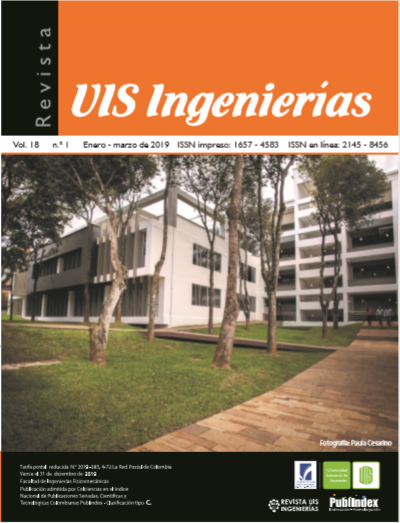Thermal analysis, mathematical modeling and simulation of a discontinuous agitation reactor for specific volume
Published 2019-01-01
Keywords
- fluid mechanics,
- heat transfer,
- stirred reactor,
- thermodynamics
How to Cite
Abstract
This paper presents the thermal analysis and mathematical modeling of a discontinuous agitation reactor. A data acquisition phase was implemented in terms of operation and utility of the agitation reactors. Subsequently, the concepts of thermodynamics, fluid mechanics, heat transfer and matter transport were applied to perform the respective thermal analysis and thus, determine the energy contained and transferred in the fluids used. In addition, a mathematical model was deduced in the EES software to examine its behavior, taking into account the operational variables subjected to various types of fluids. Finally, the physical-chemical environment of the reactor was simulated to validate the calculated data and compare them with the experimental values, relating the geometry of the equipment to the performance conditions and the specifications of the final product.
Downloads
References
T. Leevijit, C. Tongurai, G. Prateepchaikul, W. Wisutmethangoon, “Performance test of a 6-stage continuous reactor for palm methyl ester product ion,” Bioresource Technology, vol. 99, núm. 1, pp. 214–221, 2008. doi 10.1016/j.biortech.2006.11.052
S. D. Romano, E. González-Suárez, M. A. Laborde, Combustibles Alternativos. Buenos Aires, Argentina: Ediciones Cooperativas, 2005.
M. Fangrui, M. Hanna, “Biodiesel production: A Review,” Bioresource Technology, vol. 70, pp. 1-15, núm. 1, 1999. doi: 10.1016/S0960-8524(99)00025-5
S. Furuta, H. Matsuhashi, K. Arata, “Biodiesel fuel production with solid amorphous - zirconia catalysis in fixed bed reactor,” Biomass and Bioenergy, vol. 30, núm. 10, pp. 870 – 873, 2006. doi: 10.1016/j.biombioe.2005.10.010
W. G. Morales, P. Dagnino, A. Diaz, N. Polich, A. Sequeira, E. Chamorro, “Proceso semicontínuo en la transesterificación de triglicéridos de semilla de algodón”, Grupo de Investigación en Química Orgánica Biológica (Quimobi) [En línea]. Disponible en: https://www.researchgate.net/publication/267234769
K.G. Denbigh, J.C. Turner, Introducción a la teoría de los reactores químicos. México: Editorial Limusa, 1990.
M. Bayas, C. Nuñez - Aguagallo, “Diseño y construcción de un reactor continuo de mezcla completa”, Trabajo de grado, Escuela Superior Politécnica de Chimborazo, 2011 [En línea]. Disponible en: http://dspace.espoch.edu.ec/handle/123456789/1968
M. Dolors-Grau, L. Puigjaner-Corbella, “Estudio del comportamiento de reactores discontinuos y semicontinuos: modelización y comprobación experimental”, Universitat Politècnica De Catalunya, 1999. [En línea]. Disponible en: http://www.tdx.cat/bitstream/handle/10803/6463/02_grauVilalta_capitol_1.pdf;jsessionid=D7342C7FADDC5E1B0DBD4090299A32D7?sequence=2
C. Hernández-Pedrera, M. Rivera-Soto, R. Matos-Durán, Y. Piñó-Cuenca, “Estudio de sensibilidad paramétrica en reactores continuos con agitación”, Revista Tecnología Química, vol. 34, no. 1, 2014. doi: 10.1590/2224-6185.2014.1.%25x
W. McCabe, J. Smith, P. Harriott, Operaciones unitarias en ingeniería química. México: Editorial McGraw Hill, 2007.
D. Kern, Procesos de transferencia de calor. Mexico: Mc Graw Hill Book, 1999.
S. A. Klein, “Handbook Engineering Equation Solver EES,” F-Chart Software, 2016.
F. Incropera, D. P. DeWitt, Fundamentos de transferencia de calor. Pearson Educación, 1999.
D. Villa, D. Hincapié, y E. Torres, “Simulación computacional de la transferencia de calor en herramientas usadas en soldadura por fricción-agitación,” Rev. UIS Ing., vol. 14, núm. 2, pp. 19-26, 2015. doi: 10.18273/revuin.v14n2-2015003
Guia de usuario Solidworks Flow Simulation, Dassault Systèmes - SolidWorks Corporation, 2016.
G. Valle-Tamayo, L. Valbuena-Luna, C. Rojas-Beltrán, M. Cabarcas-Simancas, “Modelo numérico para el análisisy el diseño de redes de tuberías para flujo bifásico,” Rev. UIS Ing., vol. 17, núm. 2, pp. 201-214, 2018. doi: 10.18273/revuin.v17n2-2018018
J. Matsson, An introduction to SolidWorks Flow Simulation. U.S.A: Schroff Development Corp, 2013.

